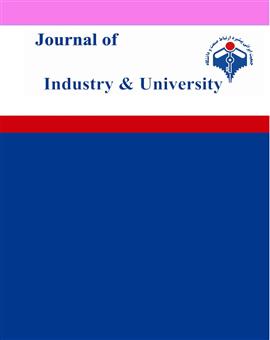Explaining the strategic position of Pardis Technology Park in the development of the country's knowledge-based economy
Subject Areas : GeneralYasin Saeidi 1 , Rasoul Rajaei 2
1 -
2 -
Keywords: Knowledge-Based Economics, Science and Technology Park, Innovation Ecosystem,
Abstract :
Science and technology parks, as an organization with the aim of increasing wealth in society, are managed by professionals to move the flow of knowledge and technology between universities, research and development institutes, private companies and the market. Through growth centers, these parks strengthen innovative organizations and facilitate reproductive processes, and act as an environment in which independent research units, affiliated with organizations and industries, are integrated and covered to support creativity and innovation. To pay. The ultimate mission of these parks is to reconcile the results of academic research with the needs of industry in order to fill the gap between industry and academia, and this will ultimately lead to the commercialization of knowledge. Therefore, due to these functions, the formation and development of many emerging technological phenomena occur from within these parks, and governments try to provide working conditions for small and medium-sized companies and attract international technology-based companies by creating a suitable environment. In Iran, in recent years, these parks have expanded significantly and in a situation where the country is facing unilateral sanctions, they have been able to play an effective role in the use of indigenous knowledge and technology. In this regard, the purpose of this article is to address the importance and main functions of science and technology parks in the world as well as in Iran. In the following, considering the role of Pardis Technology Park as the largest and most important technology park in the country in the development of knowledge-based economy and also its strategic position in the innovation ecosystem, has been studied.
1. پارک فناوری پردیس (1388). فصلنامه پارک فناوری پردیس، سال ششم، شماره 20.
2. پارک فناوری پردیس (1395). فصلنامه پارک فناوری پردیس، سال سیزدهم، شماره 45 و 44.
3. پارک فناوری پردیس (1396). فصلنامه پارک فناوری پردیس، سال چهاردهم، شماره 49.
4. پارک فناوری پردیس (1397). فصلنامه پارک فناوری پردیس، سال پانزدهم، شماره 50 و 51.
5. پارک فناوری پردیس (1397). فصلنامه پارک فناوری پردیس، سال چهاردهم، شماره 47 و 48.
6. پارک فناوری پردیس (1397). فصلنامه پارک فناوری پردیس، سال شانزدهم، شماره 52 و 53.
7. پارک فناوری پردیس (1398). فصلنامه پارک فناوری پردیس، سال شانزدهم، شماره 54 و 55.
طالبی، کامبیز، ثنائی پور، هادی، حیدری، ناصر (1390). تبیین نقش پارکهای علم و فناوری در رشد شرکتهای فناورانه محور. فصلنامه توسعه کارآفرینی، سال سوم، شماره یازدهم، صص 166-147.
9. نصر، علی، حاجی حسینی، حجت اله (1396). نقش پارکهای علم و فناوری در توسعه نوآوری و فناوری. فصلنامه رهیافت، شماره 65، صص 50-37.
10. Berbegal-Mirabent, J., Alegre, I. & Guerrero, A. Mission statements and performance: An exploratory study of science parks. Long Range Plann. 101932 (2019) doi:10.1016/j.lrp.2019.101932.
11. Ng, W. K. B., Appel-Meulenbroek, R., Cloodt, M. & Arentze, T. Towards a segmentation of science parks: A typology study on science parks in Europe. Res. Policy 48, 719–732 (2019).
12. Yigitcanlar, T., Adu-McVie, R. & Erol, I. How can contemporary innovation districts be classified? A systematic review of the literature. Land Use Policy 95, 104595 (2020).
13. Schmidt, S., Balestrin, A., Engelman, R. & Bohnenberger, M. C. The influence of innovation environments in R&D results. Rev. Adm. 51, 397–408 (2016).
14. Steruska, J., Simkova, N. & Pitner, T. Do science and technology parks improve technology transfer? Technol. Soc. 59, 101127 (2019).
15. Al-Kfairy, M., Khaddaj, S. & Mellor, R. B. Evaluating the effect of organizational architecture in developing science and technology parks under differing innovation environments. Simul. Model. Pract. Theory 100, 102036 (2020).
16. Henriques, I. C., Sobreiro, V. A. & Kimura, H. Science and technology park: Future challenges. Technol. Soc. 53, 144–160 (2018).
17. Albahari, A., Pérez-Canto, S., Barge-Gil, A. & Modrego, A. Technology Parks versus Science Parks: Does the university make the difference? Technol. Forecast. Soc. Change 116, 13–28 (2017).
18. Guadix, J., Carrillo-Castrillo, J., Onieva, L. & Navascués, J. Success variables in science and technology parks. J. Bus. Res. 69, 4870–4875 (2016).
19. Yang, C.-H., Motohashi, K. & Chen, J.-R. Are new technology-based firms located on science parks really more innovative? Res. Policy 38, 77–85 (2009).
20. Fukugawa, N. Science parks in Japan and their value-added contributions to new technology-based firms. Int. J. Ind. Organ. 24, 381–400 (2006).
21. Koh, F. C. C., Koh, W. T. H. & Tschang, F. T. An analytical framework for science parks and technology districts with an application to Singapore. J. Bus. Ventur. 20, 217–239 (2005).
22. Chan, K. F. & Lau, T. Assessing technology incubator programs in the science park: the good, the bad and the ugly. Technovation 25, 1215–1228 (2005).
23. Löfsten, H. & Lindelöf, P. Science Parks and the growth of new technology-based firms—academic-industry links, innovation and markets. Res. Policy 31, 859–876 (2002).
24. Löfsten, H. & Lindelöf, P. R&D networks and product innovation patterns—academic and non-academic new technology-based firms on Science Parks. Technovation 25, 1025–1037 (2005).
25. Lindelöf, P. & Löfsten, H. Growth, management and financing of new technology-based firms—assessing value-added contributions of firms located on and off Science Parks. Omega 30, 143–154 (2002).
26. Dettwiler, P., Lindelöf, P. & Löfsten, H. Utility of location: A comparative survey between small new technology-based firms located on and off Science Parks—Implications for facilities management. Technovation 26, 506–517 (2006).
27. Rao, (2007), Technology park development Experience and Possible Application to Jordan.


